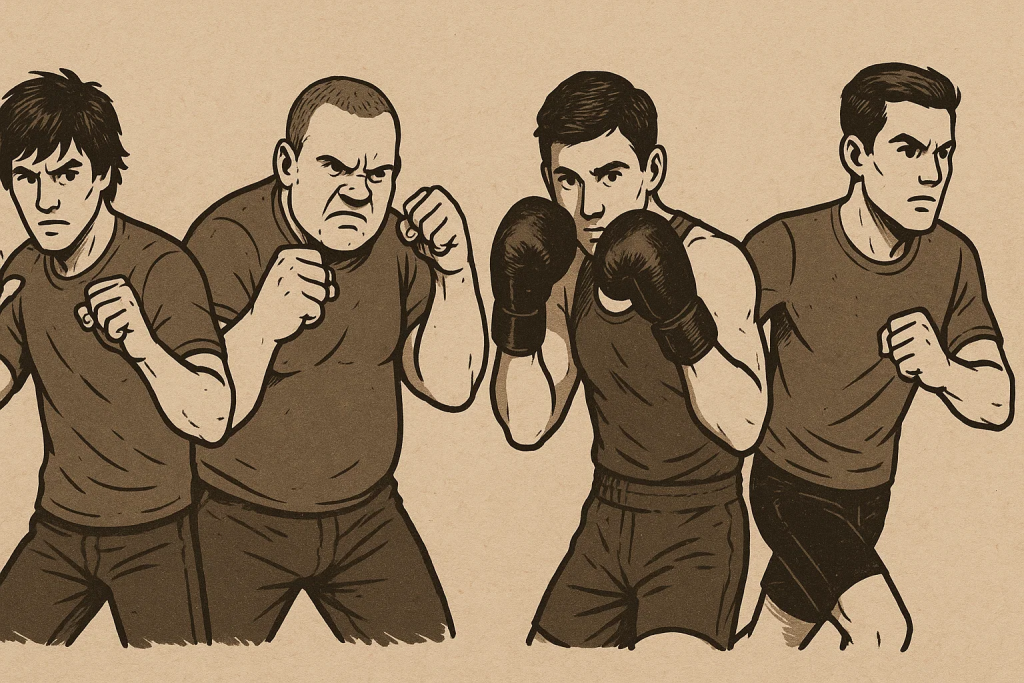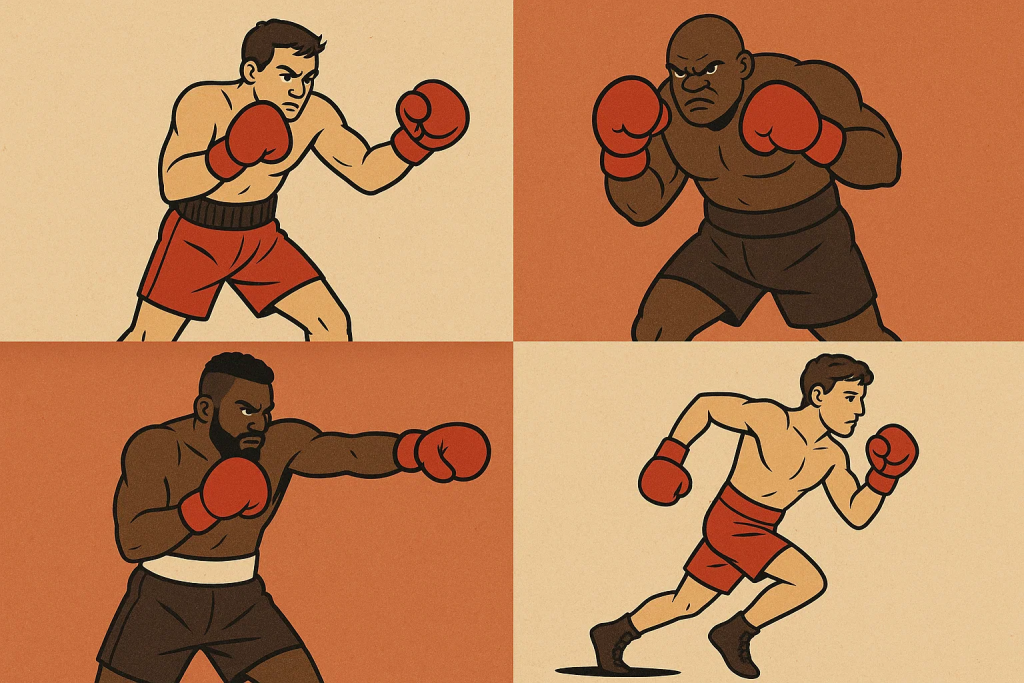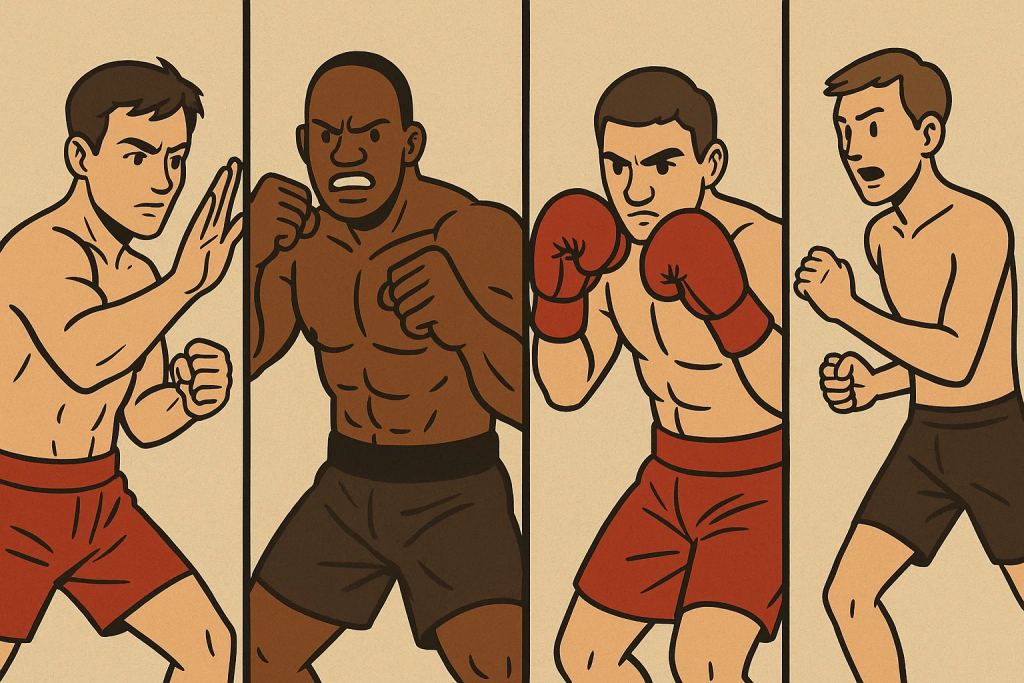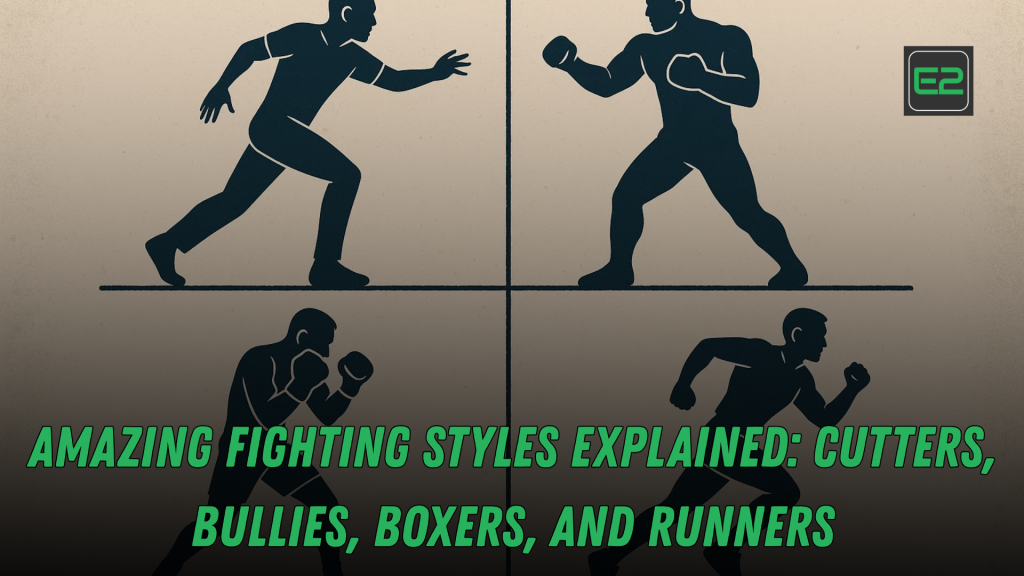In this article, we will explain four primary fighting styles—Cutters, Bullies, Boxers, and Runners—breaking down their key characteristics, strengths, weaknesses, and how they’re used effectively in the ring or octagon.
In the world of combat sports like boxing, MMA, and even martial arts, fighters often adopt unique strategies to outwit and overpower their opponents. Understanding these different fighting styles is essential not only for fans of the sport but also for fighters looking to improve their performance. Whether you’re training to fight or just trying to understand the complexities of combat sports, knowing the fighting styles can help you analyze how a match might unfold.
Table of Contents
1. The Cutter: A Precision Fighting Styles
What is a Cutter?
A Cutter is a fighter who relies on precision and technique rather than power or brute force. They tend to be agile, quick, and strategic, cutting through their opponent’s defenses with sharp, calculated strikes. Think of them as tacticians in the ring who carefully wait for the right moment to land an effective hit.
Key Characteristics of a Cutter
- Speed Over Power: Cutters are known for their quick reflexes and ability to dodge attacks while delivering rapid, well-placed blows.
- Precision: These fighters focus on hitting specific target areas on their opponent’s body, often going for weaknesses like the ribs, liver, or head.
- Patience: Cutters are typically patient, waiting for their opponent to make a mistake before striking.
Strengths and Weaknesses of this Fighting Styles
- Strengths:
- High precision and skill
- Effective against less disciplined fighters
- Ability to outmaneuver stronger opponents
- Weaknesses:
- Vulnerable to aggressive fighters who don’t give them time to set up their shots
- Can struggle against bigger or more powerful opponents
When is the Cutter Style Effective?
The Cutter style works best against fighters who are overly aggressive or lack defensive skills. By staying calm, a Cutter can avoid heavy punches while landing well-timed strikes that wear their opponent down over time.

2. The Bully: Overpowering the Opposition Fighting Styles
What is a Bully?
In combat sports, a Bully is a fighter who uses their strength, intimidation, and sheer force to overwhelm their opponent. The Bully doesn’t wait for the perfect moment to strike—they bring the fight to their opponent from the opening bell.
Key Characteristics of a Bully
- Aggression: Bullies push forward relentlessly, never allowing their opponent to dictate the pace of the fight.
- Strength and Power: Rather than relying on technique, Bullies aim to physically dominate their opponent with powerful punches, takedowns, or strikes.
- Pressure: These fighters will often overwhelm their opponent with a barrage of attacks, forcing them to retreat and lose their composure.
Strengths and Weaknesses
- Strengths:
- Intimidating and aggressive
- High endurance to keep up relentless pressure
- Strong striking power
- Weaknesses:
- Vulnerable to counter-attacks from faster fighters
- Can tire quickly if unable to land decisive hits
- Easily outmaneuvered by strategic fighters
When is the Bully Style Effective?
The Bully style is effective against fighters who lack the confidence or stamina to fight back aggressively. Bullies excel in close-range combat, where their strength can be used to land powerful blows that may finish a fight quickly.
3. The Boxer: The All-Rounder Fighting Styles
What is a Boxer?
A Boxer is often considered the most balanced fighting style, utilizing a mixture of technique, speed, and power. The boxer’s primary weapon is their hands, focusing on combinations of punches like jabs, hooks, and uppercuts. They are proficient at both offense and defense and typically excel in maintaining a controlled, composed approach throughout a fight.
Key Characteristics of a Boxer
- Combination Punching: Boxers are experts at throwing combinations that confuse and tire their opponents.
- Footwork: Boxers often have great movement in the ring, allowing them to stay elusive while positioning themselves for an effective attack.
- Defense: Good boxers are not just good at throwing punches, they are also excellent at slipping, blocking, and rolling with punches to minimize damage.
Strengths and Weaknesses
- Strengths:
- High versatility in both offensive and defensive techniques
- Good at controlling the pace of the fight
- Effective in longer matches due to strategic pacing
- Weaknesses:
- Vulnerable to fighters who have strong counter-attacks
- Can struggle against highly aggressive or brawler-type fighters who don’t follow a structured approach
When is the Boxer Style Effective?
The Boxer style works well against both aggressive and passive fighters. Their ability to control distance and pace gives them an advantage in maintaining control throughout the fight.

Terms Every Sabungero Must Know and the Amazing Language of the Cockpit
4. The Runner: Evasion and Longevity Fighting Styles
What is a Runner?
The Runner is a defensive fighter who uses speed and evasion to outlast their opponent rather than trying to dominate them physically. This style relies on maintaining distance, constantly moving, and avoiding contact whenever possible. The goal is to score points by staying out of range while hitting the opponent when opportunities arise.
Key Characteristics of a Runner
- Constant Movement: Runners are always on the move, circling around their opponent and never staying in one spot for long.
- Counter-Striking: Instead of leading the offense, a Runner waits for the opponent to make a move, then strikes back with well-timed counter-attacks.
- Endurance: Runners tend to have excellent stamina and use it to their advantage, tiring out their opponent over the course of the fight.
Strengths and Weaknesses
- Strengths:
- Ability to frustrate aggressive opponents
- High endurance allows them to avoid getting hit while still scoring
- Strong counter-attacking techniques
- Weaknesses:
- Vulnerable to opponents who can cut off the ring or control the pace of the fight
- Less effective in shorter, more explosive exchanges
When is the Runner Style Effective?
The Runner style is perfect for fighters who excel at movement and have excellent stamina. It works well against aggressive fighters who are unable to land clean strikes due to constant evasion.

Choosing the Right Fighting Styles
Each of the four fighting styles—Cutters, Bullies, Boxers, and Runners—offers a unique approach to combat. The key to success in any of these styles lies in understanding their strengths and weaknesses, and adapting them to your personal skills and strategies. Whether you’re a young fighter just starting out or a seasoned pro, choosing the right fighting style can make all the difference in your ability to win and thrive in the competitive world of combat sports.
Fighting Styles Explained: Cutters, Bullies, Boxers, and Runners explores four primary combat styles in sports like boxing and MMA:
- Cutter: A precision fighter who relies on speed and technique to land well-placed strikes, often waiting for the opponent to make a mistake. They are patient and strategic but vulnerable to aggressive fighters.
- Bully: Known for aggression and power, Bullies overwhelm their opponents with force and pressure, aiming to dominate the fight. However, they can be easily outmaneuvered by faster fighters and may tire quickly.
- Boxer: The most balanced style, combining offense and defense through punch combinations, footwork, and defensive tactics. Boxers control the pace and excel in longer fights, but they can struggle against counter-attacks from more aggressive fighters.
- Runner: A defensive fighter who uses speed, evasion, and endurance to avoid direct combat while landing counter-attacks. Runners frustrate aggressive opponents but can be vulnerable to fighters who control the pace.
Choosing the right style depends on a fighter’s skills, strategy, and the opponent’s tactics. Each style offers distinct advantages, and knowing them helps fighters and fans better understand combat sports.
What are your thoughts?
If you are looking to improve your fighting skills or just gain a deeper understanding of the different fighting styles, consider working with a coach or trainer who can help you tailor a strategy that plays to your strengths.
Frequently Asked Questions (FAQs)
1. What is the difference between a Cutter and a Boxer?
A Cutter is a more precision-focused fighter who relies on speed and technique, while a Boxer is more balanced, utilizing both offense and defense through punch combinations and footwork.
2. How do Bullies win their fights?
Bullies win by overwhelming their opponents with constant pressure, using their strength and aggression to land powerful strikes.
3. Can a Runner win against a Boxer?
Yes, a Runner can win against a Boxer by using superior movement and counter-strikes, avoiding the Boxer’s punches while landing hits when opportunities arise.
4. What is the best style for a beginner?
A Boxer style is ideal for beginners as it balances offense and defense, offering a strong foundation for various types of combat.
5. How can a fighter switch between styles during a match?
A fighter can adapt by adjusting their strategy mid-fight, switching from a more defensive or evasive style to a more aggressive or counter-attacking approach, depending on the opponent’s tactics.
